Algieba, Gamma Leonis (γ Leo), is a binary star located in the zodiac constellation Leo. With a combined apparent magnitude of 2.08, it is the second brightest point of light in Leo, after Regulus. The primary component hosts an exoplanet, Gamma1 Leonis b, discovered in 2009. Gamma Leonis lies at a distance of 130 light years from Earth. It is one of the six bright stars that form the Sickle of Leo, a conspicuous asterism that forms the lion’s mane and shoulders.
Star system
Gamma Leonis is a double star composed of two giants. The two components, Gamma1 and Gamma2 Leonis, orbit each other with a period of 510.3 years at an average distance of 170 astronomical units. They have a highly eccentric orbit that brings them within 23 astronomical units of each other and takes them as far apart as 313 astronomical units. The stars are separated by 4.24 arcseconds on the sky and can be resolved in larger binoculars and small telescopes.
The primary component, Gamma1 Leonis, is an orange giant star of the spectral type K1 III. Some sources give the stellar classification K1IIIFe-1 or K1IIIbCN-0.5, indicating an underabundance of iron (Fe) and cyanogen (CN).
Gamma1 Leonis has an apparent magnitude of 2.37. With an effective temperature of 4,470 K, it is 320 times more luminous than the Sun. It has a mass of 1.23 solar masses and, as it evolved away from the main sequence, it expanded to a size of 31.88 solar radii.
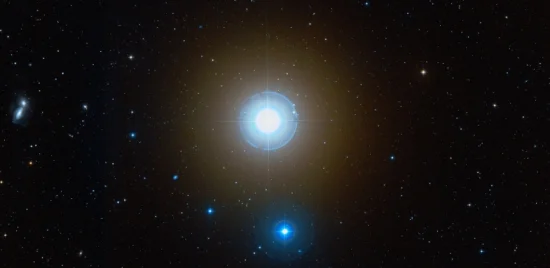
Algieba (Gamma Leonis), image: Wikisky
Different sources give different stellar parameters for Gamma1 Leonis, some suggesting a size 23 times that of the Sun and a luminosity 180 times solar, while others give a radius 29 times solar and 285 solar luminosities with a mass of 3 solar masses. The exact parameters are uncertain.
The companion, Gamma2 Leonis, is a yellow giant with the stellar classification G7 IIIb (or G7IIICN-I, indicating an underabundance of cyanogen). With an apparent magnitude of 3.64, the star is noticeably fainter than the primary. Its parameters are also uncertain, but it has about 2.5 solar masses, a radius 12 times that of the Sun, and a luminosity of 72 Suns. Other sources give a radius 10 times solar and a luminosity 50 times that of the Sun.
Gamma Leonis is a suspected variable. Its brightness has been observed to vary between magnitude 1.84 and 2.03. It is uncertain which of the two stars is responsible for the variations.
Planet
A planetary companion around Gamma1 Leonis was announced on November 6, 2009. The planet was discovered using the radial velocity method. Designated Gamma1 Leonis b, it has a mass of 8.78 ± 0.2 Jupiter masses and orbits the host star at a distance of 1.19 astronomical units, taking 1.2 years to complete an orbit. The team that discovered the planet also found an additional periodicity of 1,340 days that was not accounted for by stellar pulsations and may indicate the presence of another planet. The unconfirmed second planet would have a mass of 2.14 Jupiter masses and orbit Algieba at a distance of 2.6 astronomical units with a period of 1.340 days.
Facts
Algieba is one of the six bright stars in Leo that form an asterism known as the Sickle. Appearing like a backward question mark, the Sickle of Leo is formed by Epsilon Leonis, Rasalas (Mu Leonis), Adhafera (Zeta Leonis), Algieba, Eta Leonis and Regulus (Alpha Leonis). The asterism forms the head and shoulders of Leo, with the bright Regulus marking the heart. Regulus and the supergiant Eta Leonis form the handle of the Sickle, the inner part of the blade is outlined by Algieba, Adhafera and Rasalas, and Epsilon Leonis marks the end of the blade.
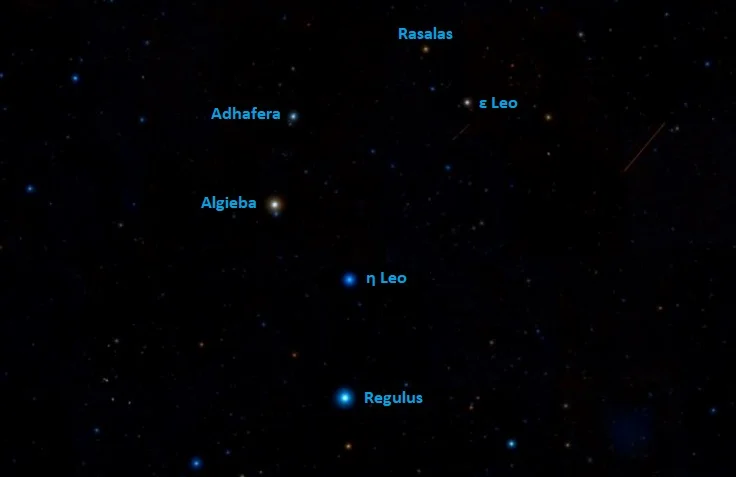
The Sickle of Leo, image: Wikisky
Even though the Gamma Leonis system is the second brightest point of light in Leo, Algieba (Gamma1 Leonis) is the fourth individual brightest star in the constellation. Both components of Gamma Leonis are outshined by Denebola (Beta Leonis) and Zosma (Delta Leonis).
Algieba appears close to the radiant of the annual Leonid meteor shower. The Leonids are associated with the comet Tempel-Tuttle. They peak in mid-November and produce meteor storms every 33 years. The last one was observed in 1998. The radiant of the meteor shower lies just west of Algieba and Adhafera, near the centre of the Sickle.
Name
The name Algieba (pronunciation: /æˈdʒiːbə/) comes from the Arabic Al-Jabhah, meaning “the forehead.” It does not refer to the star’s position in Leo, since Algieba does not mark the lion’s forehead. It is one of the stars that outline the mane. The name was also historically spelled Al Gieba and Algeiba. The formal names of Delta Scorpii (Dschubba) and Nu Scorpii (Jabbah) share the same etymology.
The name Algieba was approved by the International Astronomical Union’s (IAU) Working Group on Star Names (WGSN) on July 20, 2016. It formally applies only to the component Gamma1 Leonis.
The Latin name of Gamma Leonis was Juba (“lion’s mane”). This name was used by the 17th century German astronomer Johann Bayer, who assigned Greek letter designations to stars.
The Chinese know Algieba as the Twelfth Star of Xuanyuan (軒轅十二). The Chinese asterism called Xuanjuan, the Yellow Emperor, consists of 17 stars, including Adhafera (Zeta Leonis), Regulus (Alpha Leonis), Alterf (Lambda Leonis), Rasalas (Mu Leonis), Subra (Omicron Leonis), Epsilon Leonis, Eta Leonis, Rho Leonis, Kappa Leonis, 10 Ursae Majoris, Alpha Lyncis, and 38 Lyncis. The asterism is part of the Star mansion, one of the southern mansions of the Vermilion Bird.
Location
Algieba is very easy to identify because it is part of the Sickle of Leo. Both the star and the asterism are easily visible on a clear night. The Sickle can be found using the stars of the Big Dipper. A line drawn from Megrez through Phecda (the inner stars of the Dipper’s bowl) points the way to Regulus, the star at the base of the Sickle.
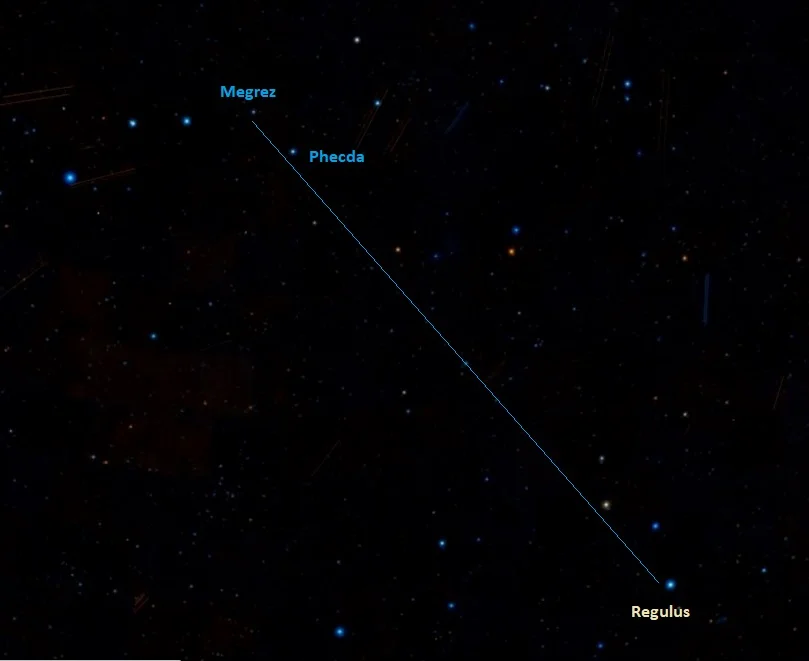
The Big Dipper and the Sickle of Leo, image: Wikisky
Algieba is the second star from Regulus.
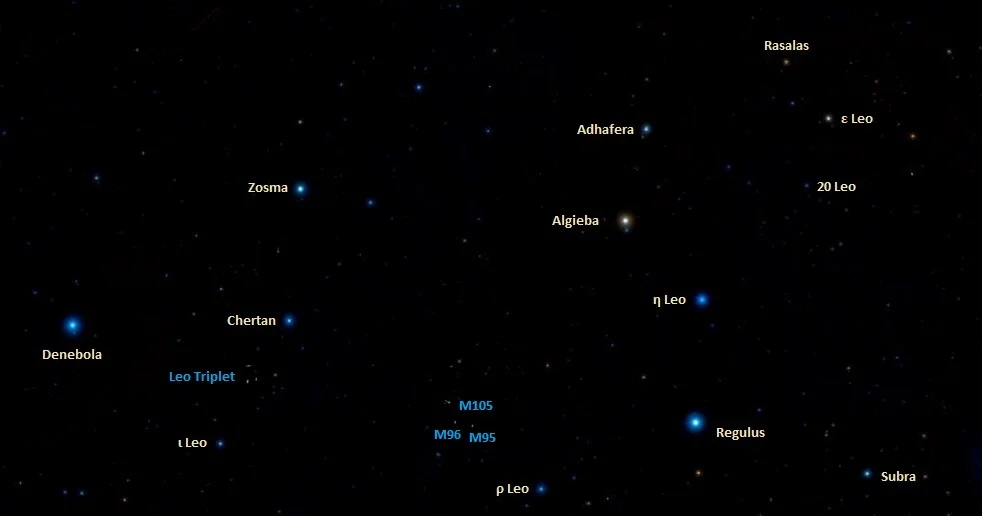
Leo stars, image: Wikisky
Algieba and its northern neighbour Adhafera can be used to find the compact galaxy group Hickson 44 (HCG 44). The group lies approximately 80 million light years away and appears about halfway between the two stars. It has four members: the unbarred spiral galaxies NGC 3190 (mag. 11.1) and NGC 3193 (mag. 10.81) and barred spirals NGC 3185 (mag. 12.17) and NGC 3187 (mag. 12.77).
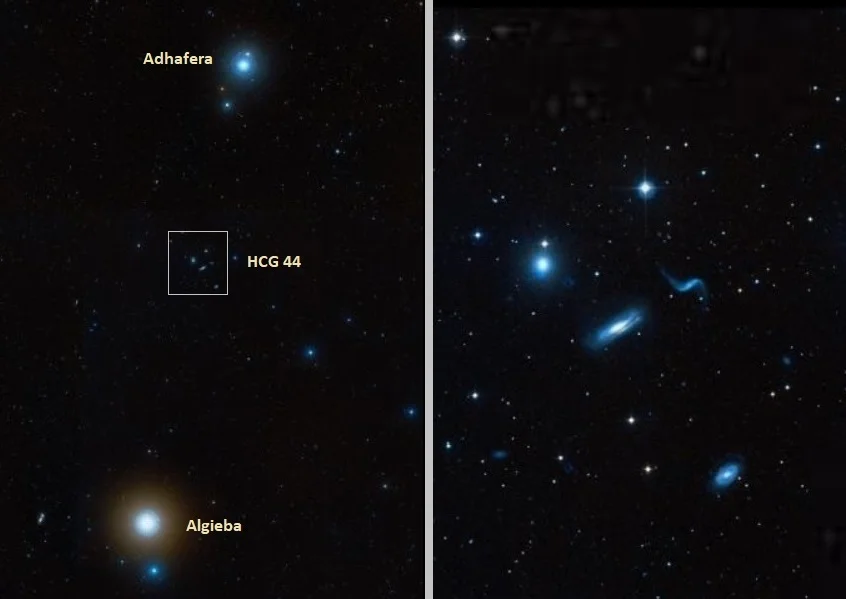
Algieba, Adhafera and Hickson 44, image: Wikisky
Several galaxies appear in the immediate vicinity of Algieba. The lenticular galaxy NGC 3222, dwarf elliptical NGC 3226 and spiral galaxy NGC 3227 lie just east of the star, and the spiral galaxy NGC 3213 is found to the southeast. NGC 3226 and NGC 3227 make an interacting pair and are catalogued as Arp 94 in the Atlas of Peculiar Galaxies. They have apparent magnitudes of 12.3 and 11.1.
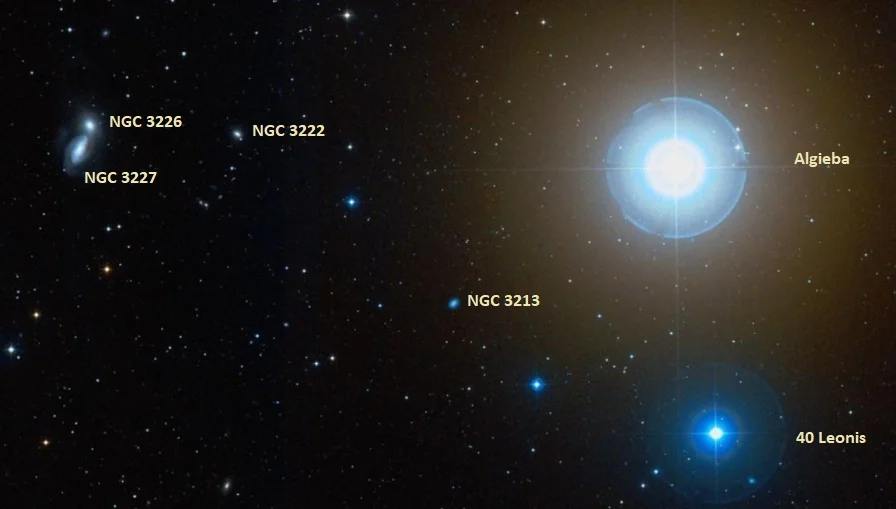
Algieba, NGC 3226, NGC 3227, NGC 3222 and NGC 3213, image: Wikisky
Constellation
Algieba is located in the constellation Leo. Stretching over 947 square degrees of the northern sky, Leo is the 12th largest of all 88 constellations. Like all zodiac constellations, it was first catalogued by the Greek astronomer Claudius Ptolemy in the 2nd century CE and is considered one of the 48 Greek constellations. In Greek mythology, the constellation is associated with the Nemean lion, one of Heracles’ Twelve Labours.
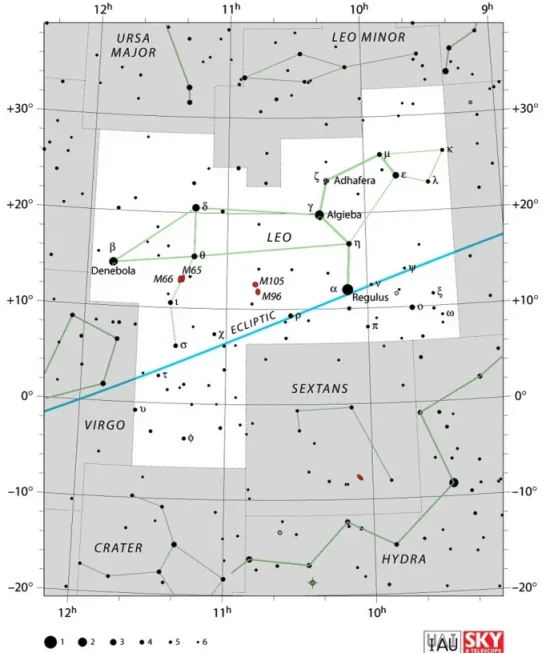
Leo constellation map by IAU and Sky&Telescope magazine
Leo is known for its distinctive shape, with the stars of the Sickle forming the lion’s head, Regulus marking the heart, Chertan and Zosma the rump, and Denebola the tail. Regulus, the constellation’s brightest star, is the 21st brightest star in the sky.
Other notable stars in Leo include the red dwarf Wolf 359, one of the nearest stars to the Sun at a distance of only 7.856 light years, Caffau’s Star, one of the oldest known stars in our galaxy, with an estimated age of 13 billion years, Icarus (MACS J1149 LS1), one of the most distant stars discovered to date, the carbon star CW Leonis, the brightest star in the infrared N-band, the Mira variable R Leonis, and the white supergiant Eta Leonis.
Leo also contains many bright deep sky objects. The best-known ones are the galaxy groups known as the Leo Triplet (Messier 65 Group) and the Leo I (Messier 96) Group. The Leo Triplet consists of the galaxies Messier 65, Messier 66 and NGC 3628 (the Hamburger Galaxy), while the Leo I group includes the bright galaxies Messier 95, Messier 96 and Messier 105.
Other interesting deep sky objects in Leo are the Frosty Leo Nebula, the Silverado Galaxy (NGC 3370), the Owl Galaxy (NGC 3758), the colliding pair NGC 3226 and NGC 3227, the elliptical galaxy NGC 3842 (the brightest galaxy in the Leo Cluster), and the Cosmic Horseshoe, a gravitationally lensed system of two galaxies located 5.2 and 10.3 gigalight years away.
The best time of year to observe the stars and deep sky objects in Leo is during the month of April, when the constellation rises high in the evening sky. The entire constellation is visible from locations between the latitudes 90° N and 65° S.
The 10 brightest stars in Leo are Regulus (Alpha Leo, mag. 1.40), Algieba (Gamma Leo, mag. 2.08), Denebola (Beta Leo, mag. 2.113), Zosma (Delta Leo, mag. 2.56), Epsilon Leonis (mag. 2.98), Chertan (Theta Leo, mag. 3.324), Adhafera (Zeta Leo, mag. 3.33), Eta Leonis (mag. 3.486), Subra (Omicron Leo, mag. 3.52), and Shaomin (Rho Leo, mag. 3.9).
Algieba – Gamma Leonis
| Spectral class | K1 III + G7 IIIb |
| Variable type | Suspected |
| U-B colour index | 1.00 |
| B-V colour index | 1.14 |
| Apparent magnitude | 2.08 (2.366, 3.644) |
| Absolute magnitude | –0.27, +0.98 |
| Distance | 130 ± 3 light years (39.9 ± 0.8 parsecs) |
| Parallax | 25.07 ± 0.52 mas |
| Radial velocity | –36.24 ± 0.18 km/s |
| Proper motion | RA: +304.30 ± 0.71 mas/yr |
| Dec.: –154.28 ± 0.36 mas/yr | |
| Constellation | Leo |
| Right ascension | 10h 19m 58.35056s |
| Declination | +19° 50′ 29.3468″ |
| Names and designations | Gamma Leonis, γ Leo, 41 Leonis, HIP 50583, BD +20°2467, AG+20 1172, UBV 9555, 2MASS J10195836+1950290, ADS 7724 AB, WDS 10200+1950, WDS J10200+1950AB, CCDM J10199+1951AB, IDS 10145+2021 AB |
Gamma1 Leonis
| Spectral class | K1 III |
| Apparent magnitude | 2.366 |
| Absolute magnitude | –0.27 |
| Parallax | 25.96 ± 0.83 mas |
| Radial velocity | -36.98 ± 0.46 km/s |
| Proper motion | RA: +310.8 ± 1.1 mas/yr |
| Dec.: -152.9 ± 0.7 mas/yr | |
| Mass | 1.23 ± 0.21 M☉ |
| Luminosity | 320 L☉ |
| Radius | 31.88 ± 1.61 R☉ |
| Temperature | 4,470 K |
| Metallicity | –0.49 ± 0.12 dex |
| Surface gravity | 2.35 cgs |
| Right ascension | 10h 19m 58.354462s |
| Declination | +19° 50’ 29.35920’’ |
| Names and designations | Algieba, Gamma Leonis A, Gamma1 Leonis, γ Leo A, γ1 Leo, 41 Leonis A, HD 89484, HR 4057, SAO 81298, BD+20 2467A, GC 14177, GCRV 6502, PPM 127320, LTT 12764, NLTT 24029, PLX 2423, IRAS 10172+2005, TYC 1423-1349-1, UBV M 16128, ADS 7724 A, CCDM J10199+1951A, IDS 10145+2021 A, WDS J10200+1950A |
Gamma2 Leonis
| Spectral class | G7 IIIb |
| Apparent magnitude | 3.644 |
| Absolute magnitude | +0.98 |
| Parallax | 25.96 ± 0.83 mas |
| Radial velocity | -36.3 ± 0.9 km/s |
| Proper motion | RA: +306.4 ± 3.3 mas/yr |
| Dec.: -160.8 ± 2.3 mas/yr | |
| Mass | ~2.5 M☉ |
| Luminosity | ~72 L☉ |
| Radius | ~12 R☉ |
| Temperature | 4,980 K |
| Metallicity | –0.52 ± 0.11 dex |
| Surface gravity | 2.98 cgs |
| Right ascension | 10h 19m 58.619717s |
| Declination | +19° 50’ 26.70347’’ |
| Names and designations | Gamma Leonis B, Gamma2 Leonis, γ Leo B, γ2 Leo, 41 Leonis B, HD 89485, HR 4058, SAO 81299, BD+20 2467B, GC 14178, GCRV 6503, LTT 12765, NLTT 24030, TYC 1423-1349-2, ADS 7724 B, CCDM J10199+1951B, IDS 10145+2021 B, WDS J10200+1950B |